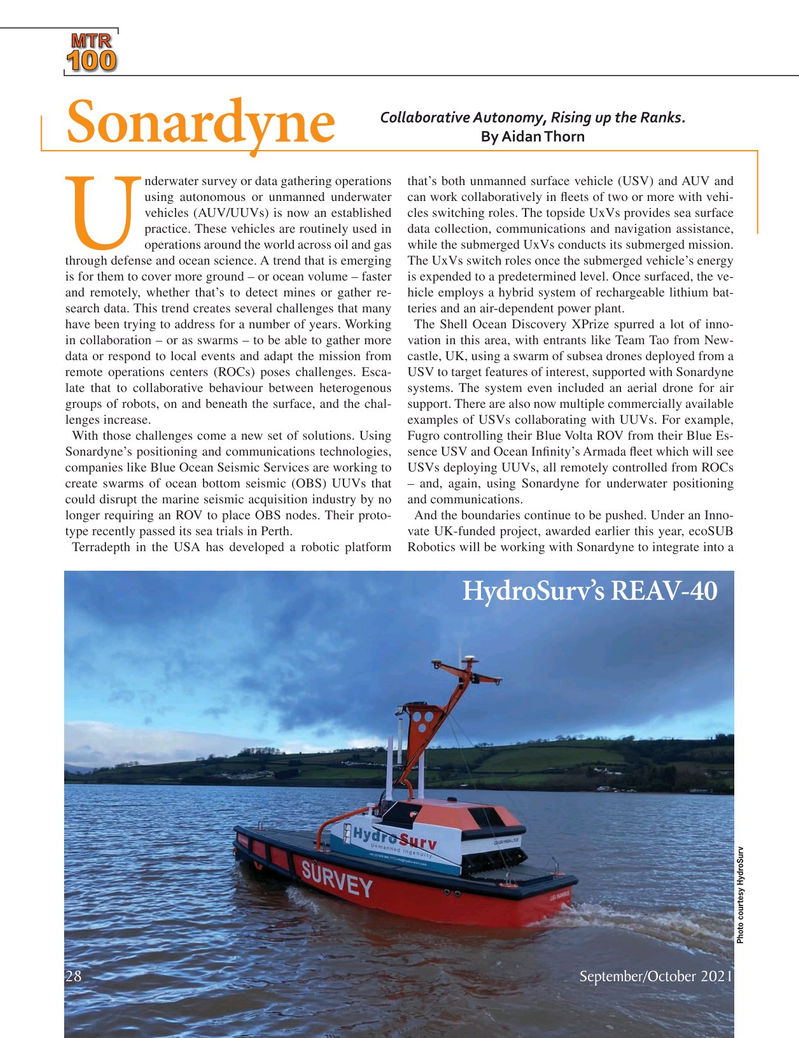
Page 28: of Marine Technology Magazine (September 2021)
MTR100: Focus on 100 Leading Companies, People and Innovations in the Subsea Space
Read this page in Pdf, Flash or Html5 edition of September 2021 Marine Technology Magazine
MTTTTTTTTTTTTTRM M M M M M M M M M M M M M M M M M M M M M M M M M M M MTRRRRRRRRRRRRRRRRRRRRRRRRRRRMTTTTTTTTTTTTTRMTR 100000000000000001111111111111111111111111111100000000000000000000000000000010000000000000000100
Collaborative Autonomy, Rising up the Ranks.
By Aidan Thorn
Sonardyne nderwater survey or data gathering operations that’s both unmanned surface vehicle (USV) and AUV and using autonomous or unmanned underwater can work collaboratively in ? eets of two or more with vehi- vehicles (AUV/UUVs) is now an established cles switching roles. The topside UxVs provides sea surface practice. These vehicles are routinely used in data collection, communications and navigation assistance,
U operations around the world across oil and gas while the submerged UxVs conducts its submerged mission. through defense and ocean science. A trend that is emerging The UxVs switch roles once the submerged vehicle’s energy is for them to cover more ground – or ocean volume – faster is expended to a predetermined level. Once surfaced, the ve- and remotely, whether that’s to detect mines or gather re- hicle employs a hybrid system of rechargeable lithium bat- search data. This trend creates several challenges that many teries and an air-dependent power plant.
have been trying to address for a number of years. Working The Shell Ocean Discovery XPrize spurred a lot of inno- in collaboration – or as swarms – to be able to gather more vation in this area, with entrants like Team Tao from New- data or respond to local events and adapt the mission from castle, UK, using a swarm of subsea drones deployed from a remote operations centers (ROCs) poses challenges. Esca- USV to target features of interest, supported with Sonardyne late that to collaborative behaviour between heterogenous systems. The system even included an aerial drone for air groups of robots, on and beneath the surface, and the chal- support. There are also now multiple commercially available lenges increase. examples of USVs collaborating with UUVs. For example,
With those challenges come a new set of solutions. Using Fugro controlling their Blue Volta ROV from their Blue Es-
Sonardyne’s positioning and communications technologies, sence USV and Ocean In? nity’s Armada ? eet which will see companies like Blue Ocean Seismic Services are working to USVs deploying UUVs, all remotely controlled from ROCs create swarms of ocean bottom seismic (OBS) UUVs that – and, again, using Sonardyne for underwater positioning could disrupt the marine seismic acquisition industry by no and communications. longer requiring an ROV to place OBS nodes. Their proto- And the boundaries continue to be pushed. Under an Inno- type recently passed its sea trials in Perth. vate UK-funded project, awarded earlier this year, ecoSUB
Terradepth in the USA has developed a robotic platform Robotics will be working with Sonardyne to integrate into a
HydroSurv’s REAV-40
Photo courtesy HydroSurv 28 September/October 2021
MTR #7 (18-33).indd 28 9/22/2021 7:59:00 AM

 27
27

 29
29
